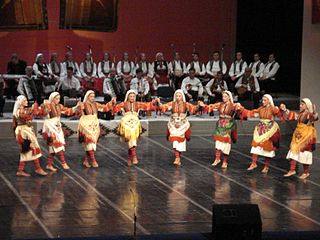
A proscenium is the metaphorical vertical plane of space in a theatre, usually surrounded on the top and sides by a physical proscenium arch and on the bottom by the stage floor itself, which serves as the frame into which the audience observes from a more or less unified angle the events taking place upon the stage during a theatrical performance. The concept of the fourth wall of the theatre stage space that faces the audience is essentially the same.

The music of Greece is as diverse and celebrated. as its history. Greek music separates into two parts: Greek traditional music and Byzantine music, with more eastern sounds. These compositions have existed for millennia: they originated in the Byzantine period and Greek antiquity; there is a continuous development which appears in the language, the rhythm, the structure and the melody. Music is a significant aspect of Hellenic culture, both within Greece and in the diaspora.

Hora, also known as horo and oro, is a type of circle dance originating in the Balkans but also found in other countries.

Circle dance, or chain dance, is a style of dance done in a circle or semicircle to musical accompaniment, such as rhythm instruments and singing. Circle dancing is probably the oldest known dance formation and was part of community life from when people first started to dance.

Zeibekiko is a Greek folk dance.

Continental Greece, colloquially known as Roúmeli (Ρούμελη), is a traditional geographic region of Greece. In English the area is usually called Central Greece, but the equivalent Greek term is more rarely used.

Kochari (Armenian: Քոչարի, is an Armenian folk dance.

The Pentozali or Pentozalis is the trademark folk dance of the island of Crete. It takes its name from the fifth (pente) attempt or step of Cretans to liberate Crete from Ottomans. The name can thus be translated as "five-steps". Also in the spirit of wordplay, ζάλη zali means dizziness, and the name of the dance can also be understood ("five-dizzy") as one that can make the dancers dizzy five times over. The dance has ten steps.

Music of Thrace is the music of Thrace, a region in Southeastern Europe spread over southern Bulgaria, northeastern Greece, and European Turkey.

Sousta is the name of a folk dance in Cyprus and Crete which is danced in Greece and generally in the Balkans. The music is generally played with a lyre, laouto, and mandolin.
The Tsamikos or Kleftikos is a popular traditional folk dance of Greece, done to music of 3/4 meter.

Greek folk music includes a variety of Greek styles played by ethnic Greeks in Greece, Cyprus, Australia, the United States and elsewhere. Apart from the common music found all-around Greece, there are distinct types of folk music, sometimes related to the history or simply the taste of the specific places.

Greek dances (horos) is a very old tradition, being referred to by authors such as Plato, Aristotle, Plutarch and Lucian. There are different styles and interpretations from all of the islands and surrounding mainland areas. Each region formed its own choreography and style to fit in with their own ways. For example, island dances have more of a different smooth flow to them, while Pontic dancing closer to Black Sea, is very sharp. There are over 10,000 traditional dances that come from all regions of Greece. There are also pan-Hellenic dances, which have been adopted throughout the Greek world. These include the syrtos, kalamatianos, pyrrhichios, hasapiko and sirtaki.

Castanets, also known as clackers or palillos, are a percussion instrument (idiophone), used in Spanish, Kalo, Moorish, Ottoman, Italian, Sephardic, Swiss, and Portuguese music. In ancient Greece and ancient Rome there was a similar instrument called crotalum.
The instrument consists of a pair of concave shells joined on one edge by a string. They are held in the hand and used to produce clicks for rhythmic accents or a ripping or rattling sound consisting of a rapid series of clicks. They are traditionally made of hardwood, although fibreglass is becoming increasingly popular.
Ai Georgis is a dance from the village of Nestani in Arkadia, a region of Greece in the Peloponnesus which takes its name from the mythological character Arcas. The dance is performed and danced on the feast day of St George usually after Easter Sunday.

The Kalamatianós is one of the best known dances of Greece. It is a popular Greek folkdance throughout Greece, Cyprus and internationally and is often performed at many social gatherings worldwide. As is the case with most Greek folk dances, it is danced in chain with a counterclockwise rotation, the dancers holding hands.

Syrtos is, in classical and modern Greece: a folk dance in which the dancers link hands to form a chain or circle, headed by a leader who intermittently breaks away to perform improvised steps.

Endeka Kozanis is a traditional Greek dance, mostly danced at the region of Kozani. According to one point of view, it is a dance that was being danced at the weddings.

Tsiniaris, is a circle Cretan folk dance from Agios Vasileios, Crete, Greece. It is usually danced by older local persons and is very widespread in Rethymno.









